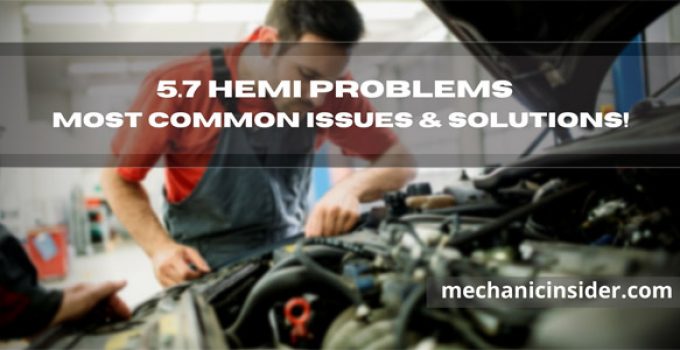The 5.7 Hemi engine is one of the most popular products of the Chrysler company. It is the third-generation member of Chrysler’s V8 Hemi engine family and was produced to replace the 5.9 L V8 Magnum Engine. Afterwards, it became the only gasoline engine available in the Ram Heavy Duty series.
Generally speaking, the ram 5.7 Hemi engine has no significant design flaws and is overall a very reliable engine. But there are some common issues that many owners are faced with, and here we are going to talk about it.
Before we move on to the problems, we need to know about the engine first so we can get a good grasp and understand the issues more deeply. Let’s get right to it, shall we?
The 5.7 Hemi Engine
The word Hemi comes from the shortening of the word ‘Hemispherical.’ The Hemi 5.7 has inherited this name from the first generation of V8 engines due to the hemispherical shape of their combustion chamber. While the 5.7 Hemi engine does not have a full hemispherical shaped combustion chamber, it has still retained the name from its predecessors.
The Hemispherical Shaped Combustion Chamber
The job of a combustion chamber sounds simple enough. It has to take in the pressure and expansion and contain it so that that pressure can push the piston down to the bore. The combustion chamber also includes the spark plug inside it, which is the ignition source for engines run by gasoline.
The hemi chamber’s spherical shape produces a sharper rise in the ignition chamber pressure compared to the other typical overhead valve design with a wedge-shaped compartment. If the spark plug, the ignition source, is adjacent to the heart of the combustion chamber, the pressure reflected off of the chamber’s walls results in a more well organized and faster rise in pressure. As all the fuel inside the combustion chamber burns up in a comparatively shorter amount of time, the pressure builds up during an earlier phase of each stroke, resulting in increased efficiency of the Hemi engine.
But it is not all good. While the hemispheric shape promotes a faster pressure increase time, it is also the cause of elevated emissions of nitrogen oxide. If the manufacturers did not take extra steps to mitigate this problem, the third generation Hemi engines would remain an impossibility for production cars.
5.7 Hemi Specs
Unlike the earlier generation models, this third-generation engine now has a flatter design with squish shelves on both sides. These squish shelves help reduce emissions and increase efficiency. The Gen III engine sports aluminum crossflow cylinders heads with two valves, and each cylinder has two spark plugs.
The engine was designed with a Multiple Displacement System (MDS) to reduce harmful emissions and improve fuel consumption. When our car is cruising at a constant, steady speed, the MDS turns off four of the machine’s cylinders. It also keeps the intake and exhaust valves closed by controlling the flow of oil.
In 2009, Chrysler revised the 345 Hemi engine. The most significant part of the revision was the implementation of the Variable Valve Timing (VVT) system. It was added for better volumetric efficiency and improved breathing under a wide variety of conditions. By utilizing VVT, Chrysler could upgrade the camshaft to increase torque when the load is light and use the MDS almost half of the time so that the car can run at 70 mph using only four cylinders.
5.7 Hemi Problems
Now that we have quantifiable knowledge about the 5.7 Hemi engine, let us check out the common problems that occur within the machine and how we can get past them.
Hemi Tick
The late-model Chrysler Hemi engines are plagued with hydraulic lifters and associated valve train issues for some time now, and it is no secret amongst the engine enthusiasts and builders.
If we look through the internet forums, we can see every user talking about a ticking noise that is so talked about among the users that this noise has been dubbed as the ‘Hemi Tick.’
Some people believe that the tick is totally harmless. They claim that it is merely a characteristic of the engine’s pushrod design. Because, let us face it, a pushrod engine has more moving parts, so a little bit of noise is not something totally out of the ordinary. Even Chrysler themselves have never addressed this issue adequately.
And it is a standard dealer response to address them as a character amongst the third generation Hemi engines and that all the Hemi engines make this noise.
But, the thing is, this problem affects even the most precisely degreed camshafts. Even at steady throttle, airflow can vary, and the ECU will try to solve this problem by adjusting it with fuel changes. And gradually, it will make another solution that will lower the performance, but the tick will still be there.
Causes:
- Lack of Lubrication: The ticking noise mainly occurs due to a lack of lubrication. Lubricants such as fuel and oil flow between metallic parts. By flowing between the components, lubricants provide cushioning so that the parts do not collide against each other. Tapping or ticking sounds can originate from various sources such as the valves, lifters, and fuel injectors.
- Lifters: If there is an issue with the lifters, it is most likely to start producing a ticking noise. There has been a lot of speculation about what the cause could be to make the lifters tap on a few Hemis, particularly the 5.7 liters Hemi engines. If the lifters are tapping, we should check whether we are employing the accurate kind of oil or if the amount of oil is optimum.
- Fuel: If we use a low-quality fuel, it can cause the 5.7 Hemi to tick. Fuels with a high amount of ethanol or low octane might not correctly grease the fuel injectors and can lead the way to a ticking or slight tapping noise.
Low octane gas can also cause a combustion knock in the high-performance engines. If we switch to a high-quality octane or use fuel additives, that can help avert this problem and might be able to minimize or even correct the Hemi tick.
- Valves: The exhaust and intake valves on the Hemi might also be the cause of the occurrence of the ticking sound. The valve tapping may arise due to a variety of reasons. If there is not enough lubricating agent or a problem in the valve’s springs that close and open them, a ticking noise may be heard.
Solution:
Removing the ticking or tapping sound from our 5.7 Hemi engine is a simple enough process. The components that we are going to need to remove the noise are available at any auto parts store.
- Washing the Lifters: We are going to open the hood and then remove the oil fill cap. Now, we have to take a bottle of engine oil system cleaner. We are going to take this bottle and empty it into the oil spout. It does not matter if we are overfilling the engine as the excess oil will ensure that a sufficient amount of oil is washing the lifters.
- Drive: After replacing the oil cap, we have to maintain casual driving for a 12 to 24 hour period. As the engine oil system cleaner is an oil-based detergent, it will not damage the engine but make sure the cleaning is done thoroughly.
- Oil Change: After a day that we added the chemical, we have to do a complete oil change of our vehicle. We can do the oil switch by ourselves, or we can take the help of a professional.
The oil change procedure is not a complicated matter. Nothing particular is necessary to do this procedure. The super cleansers in the oil system cleaner that we used the day before should remove the excess debris on the lifters and correct the ticking noise.
Cam and Lifter Failure
A valve lifter is an engine component that is mounted on a camshaft. The camshaft is operated by the crankshaft via a belt or a chain. And the crankshaft spins as a result of the reciprocating motions of the pistons as the combustion caused by the cylinders displace them.
The Lion’s share of problems that the 5.7 Hemi engine users have complained about is cam and lifter failure. It happens when a stall occurs during inactivity or stopping or if the engine seizes up unexpectedly.
Even amongst the users who complained about this failure, the degree of the failure differs. Some of these complaints mention only bent pushrods or worn-down 5.7 Hemi lifters and cam.
Some of the complaints mention a more severe problem where their pushrods have been twisted like a pretzel or been pretzeled. We should also note that the vehicles that idle a lot, such as the fleet vehicles, seem to suffer more from this problem.
Causes:
- High Mileage: Older engines with more mileage on them are more likely to suffer from cam and lifter failures. And if it is coupled with low maintenance such as infrequent filter and oil changes, the wearing process accelerates at a rate proportionate to the level of neglect.
- Oil Level & Condition: If the oil crankcase level is excessively low to provide sufficient oil pressure to reach the upper valve train parts, then the valve lifters will starve for lubrication. In the case that the oil pickup screen cannot even temporarily pull oil, the lifters may suffer from insufficient lubrication.
- Oil Viscosity: It is crucial to maintain proper oil viscosity to reduce component wear and to maintain good engine performance. Oils with a heavier viscosity sport good oil pressure, but their flow rate are comparatively low. In contrast, the low viscosity oils promote a reasonable flow rate but have lower oil pressure.
Solutions:
After assaying the 5.7 Hemi engine’s components (assay refers to the testing of an ore or a metal to determine its quality and ingredients), the testers have come to the conclusion that Chrysler has not used any low-quality alloys to build the 345 Hemi crate engines.
In the test, the camshaft and lifter wheel both scored 57 RC (Rockwell Hardness). This indicates that the components received proper treatment. And even though they have not entirely dismissed the role of MDS in the wearing of the cam and lifter, they stated that that is mere speculation and will need further research.
So, it all finally comes down to one possible solution. The 5.7 Hemi engine is known to have a sensitivity to the condition of the oil. Chrysler has recommended the 5W-20 oil for the 5.7 Hemi engines. With this water-thin oil in a V8 engine, the oil can splash off of the crank and travel up to the cam easier.
Multi-Displacement System (MDS)
Newer generation Hemi engines are featured with a Multi-Displacement System. There are not necessarily extensive issues with the MDS but rather complaints about the whole system. While some users say that they have been using Hemi with MDS without any issues, others say that the 5.7 Hemi with Multiple Displacement System (MDS) does not function seamlessly at all. Some complaints even mention the droning of the engine or being able to feel the shift.
Solution:
For those of us who are not pro-MDS, there are several non-MDS lifter choices available. It ranges from stock non-MDS lifters to Hellcat lifters and even high-performance lifters from Comp cams.
To install these non-MDS lifters, we may need a set of the head gasket, head bolt set, and front timing cover gasket. We will also need four plugs to install the lifter into the valley.
Conclusion
The third-generation Hemi engine is overall very reliable. Over the years, it has earned its reputation as a sturdy workhorse of a machine, and there are no questions about the Hemi’s reliability. While it does have its quirks, the 5.7 Hemi engines are some of the best engines in the market!



